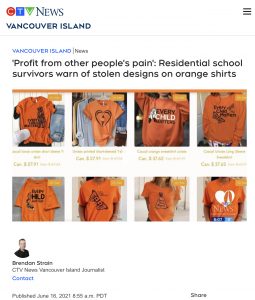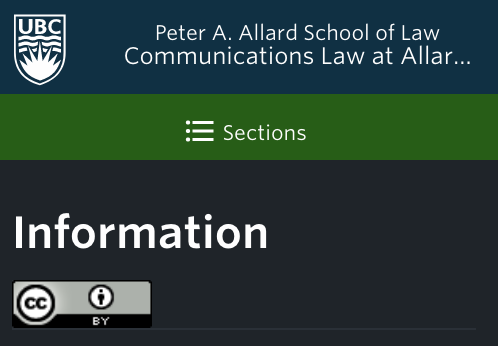 Hi everyone,
Hi everyone,
This week I’ve been thinking about the intersections between IP protections and activism as well as how infringements to such IP can cause real harm to marginalized communities.
I remembered a chat I had with an associate at a large Vancouver firm who was discussing taking on a pro-bono case to represent the artist behind the Orange Shirt Day design who has had their work reprinted on merchandise and resold by various companies who profit off of this residential school awareness-raising logo without their consent.
This article by CTV news titled “‘Profit from other people’s pain’: Residential School Survivors Warn of Stolen Designs on Orange Shirts” touches on the social, cultural and economic harms that occur when IP protections on property of this nature get infringed and exploited to the detriment of Indigenous communities.
Phyllis Webstad (the person whose shirt was taken away from her in a residential school as a young girl that sparked the creation of Orange Shirt Day) “wants consumers to be aware when purchasing a shirt online” and be educated so that they can make sure that designs aren’t stolen and to check where the proceeds of their purchase are being sent to. This comment had me thinking about the importance of the public being “educated” enough about IP law to understand what property is protected and what actions can constitute infringement in order to follow Webstad’s advice in being able to check if designs purchased are stolen from original artists before making a purchase. The economic rights tied back to a trademarked logo or other form of IP property are also another important element for consumers to understand in order to make informed decisions on whether the proceeds are going to the original artist or not—but in the world of layered e-commerce, I wonder if tracking the chain of where and to whom proceeds end up going to is as transparent as it would need to be for consumers to make such decisions. Accordingly, should there be a requirement for goods sold (especially in the realm of activism) to transparently disclose where and to whom proceeds are going to in order to allow consumers to ensure that the IP owner/their chosen cause are adequately compensated?
In this article, Thompson (a partner at Thompson Cooper) notes that it is a “complicated process to try and receive compensation or get a website to stop, especially if a company is located outside of Canada”—the article notes that “when those proceeds land in the hands of an overseas company, it’s not supporting the orange shirt cause in Canada”. Thompson also adds that he “would file for copyright to register the copyright because in some jurisdictions having a registered copyright actually is a precondition to starting court action” and he would also send out a series of demand letters asking those parties to stop what they’re doing and to determine if the artist can receive compensation. These remarks had me thinking about the sheer cost it would have on an ie. Indigenous artist as in this case, marginalized community or equity-seeking group creating IP protected art work to raise-awareness for them to be able to seek these legal remedies or actions in defence of their stolen work. If the entire goal of such artists/groups is to raise as much money for the cause they are working to support, it is disheartening to learn about the complicated, time consuming and costly process it would take for them to hire counsel to pursue these legal actions upon an IP violation. The partner’s comments also made it sound that these attempts may also not be successful, especially when it comes to companies outside of Canada; therefore, how can IP law expand to ensure adequate, pragmatic and succesful protections and remedies are available at no/reasonable costs to marginalized/equity-seeking groups?
Therefore, when it comes to activism and IP law being used as a tool to support equity-seeking and marginalized communities and causes, what other solutions can be thought of to ensure adequate protections and remedies upon infringement can be accessible and efficient to ensure already harmed groups don’t get further exploited/further harmed?
 Copyright & Social Media
Copyright & Social Media Communications Law
Communications Law